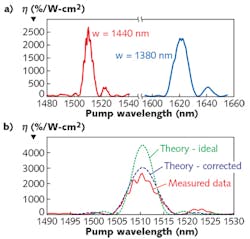Wavelength Conversion: PPLN waveguide wavelength-conversion efficiency improves by a factor of 20

One of the most effective nonlinear optical crystals for wavelength conversion of light in the near-infrared (near-IR) and visible spectral regions is periodically poled lithium niobate (PPLN), in which periodic domain inversions (within which the crystal’s electric dipoles align) in the LN crystal are produced using a series of electrodes. The periodic poling, in which every other domain is flipped, allows light to be quasi-phase-matched (QPM) so that the frequency-converted light does not destructively interfere with itself as it travels through the crystal.
Because the optical nonlinearities causing the wavelength conversion scale strongly with intensity, using the PPLN in a waveguide format strongly boosts the efficiency of the wavelength conversion. And the smaller the mode size in the waveguide for the same input optical power, the higher the conversion efficiency (all else staying the same). One challenge in producing efficient PPLN wavelength-conversion waveguides is creating a high core-to-cladding index contrast to keep the mode size in the waveguide small, the nonlinear interaction strengths high, and thus the interaction length short.
Another approach, bonding a single-crystal submicrometer-thick LN film to a low-index silicon dioxide (SiO2) substrate, has produced more-efficient wavelength-conversion efficiencies, but has had problems in fabrication tolerances that result in lower-than-ideal efficiency.
Now, a group of researchers from Harvard University (Cambridge, MA), the City University of Hong Kong (Kowloon, Hong Kong, China), Stanford University (Stanford, CA), and the California Institute of Technology (Pasadena, CA) has solved problems related to thin-film PPLN waveguides to create devices with normalized conversion efficiencies of 2600%/W-cm2, which they say is more than 20X higher than what has been achieved in state-of-the-art diffused waveguides.1
High optical confinement
The waveguides were fabricated on a magnesium-oxide-doped LN-on-insulator substrate, first making the electrodes via photolithography and liftoff. The x-cut LN ridge waveguides have a thickness of 600 nm and a Z waveguide top width of on the order of 1400 nm. A series of precisely fabricated electrodes placed alongside the waveguide produce a poling period of 4 µm, the first-order period required for QPM. To create the periodic domain inversions, the researchers submerged the device in oil at room temperature and applied a number of 5 ms, 580 V electrical pulses, creating a 4-mm-long poled region.
Light from a laser source tunable over a 1480–1680 nm wavelength region was end-coupled via optical fiber into the waveguide through a TE polarizer. The generated second-harmonic (SH) light was collected by an optical fiber and analyzed by a photodetector (see figure). The measured efficiencies for two different wavelengths peaked at 2600%/W-cm2 and 2300%/W-cm2, respectively. The highest measured absolute efficiency was 53%, corresponding to the generation of 117 mW of SH (775 nm) light for a pump power of 220 mW.
The difference between the experimental values and the theoretical efficiency value of about 4000%/W-cm2 can likely be attributed to inhomogeneity of the thin-film thickness of the waveguide along its length, say the researchers. They believe that increasing the device length to around 2 to 3 cm could push the overall conversion efficiency toward 100% for input powers of a few milliwatts.
REFERENCE
1. C. Wang et al., Optica (2018); https://doi.org/10.1364/optica.5.001438.
About the Author
John Wallace
Senior Technical Editor (1998-2022)
John Wallace was with Laser Focus World for nearly 25 years, retiring in late June 2022. He obtained a bachelor's degree in mechanical engineering and physics at Rutgers University and a master's in optical engineering at the University of Rochester. Before becoming an editor, John worked as an engineer at RCA, Exxon, Eastman Kodak, and GCA Corporation.
